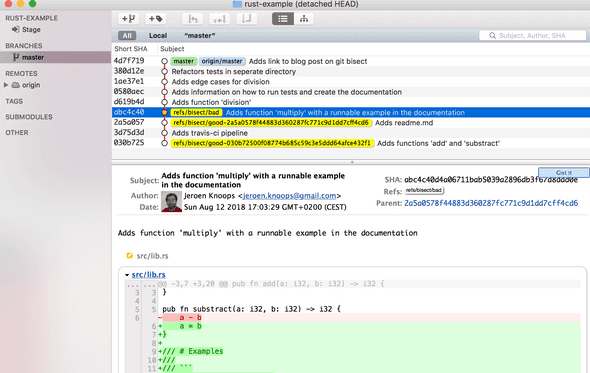

- #Github gitx how to
- #Github gitx update
- #Github gitx manual
- #Github gitx Patch
- #Github gitx download
You can also pass the -rebase flag to pull, which is how I usually work. As with subversion, this can result in a conflict. By default, git applies the "recursive" strategy, which tries to merge your current files with the remote files at the most recent revision. If you did not manually save off a diff file, there is no way to get back to the status from before you made the change. If a merge was unsuccessful, subversion will tell you that a conflict has occurred. Here, subversion will apply a merge strategy to attempt to merge the remote changes with the local ones that you made.
#Github gitx update
Now that we have our local changes, the next step is to update from the remote. I sometimes break up the changes into several granular commits, if appropriate. My personal process for making the commit in git almost always involves the gitx GUI, which lets me see the changes for each individual file, select the files (or chunks in the files) to commit, and then commit the whole thing. I have a simple script which handles this
#Github gitx Patch
When I need three-way merging, which isn't often - usually patch can resync simple things like line offsets - it's handled by a file comparison tool. Instead, I extract all my local changes into a diff, then I update my local tree, and then I merge my diff back into the updated tree and commit. Here's an example comment from the Hacker News post: I'll tell you what happens when I use svn and there's been an upstream change: I never update my local tree with local modifications.
#Github gitx manual
In subversion, the normal workflow does not involve making a change, but apparently some people make manual diffs in order to have a local copy of the changes before updating from the remote. In git, you make a local commit, marking the difference between the most recent pulled version (master) and the changes you made. In both git and subversion, you make the change using a normal text editor. This retrieves the entire repository, including other branches and tags. In git, this is accomplished via git clone git://url/to/repo (the http protocol is also possible). This retrieves the most recent revision of the trunk branch of the repository. In subversion, this is accomplished via svn checkout svn://url/to/repo/trunk. The very first step when working with a repository is to clone it. In any event, I'll step through my personal workflow for his scenario, contrasting with subversion as I go. While I won't get into the merit of his user experience complaints, I do want to talk about his specific use-case and how I personally work with it in git.īest I can tell, Mike Taylor (the guy in the post) either tried to figure out a standard git workflow on his own, or he followed poor instructions that tried to bootstrap someone from an svn background while intentionally leaving out important information. coding 2.A recent post that was highly ranked on Hacker News complained about common git workflows causing him serious pain. & git commit –amend”, the SHA value of your commit changes but the change-id won’t change.Ĭhange-id will help gerrit to recognize all your versions of the same commit.įollow the following step to push a commit to gerrit.

This commit-msg hook is a small tool that will generate a change-id whenever you create a new commit.Īfter your “git add. In the step 4 in the previous section, you need to clone with commit-msg hook. It’s like you have different versions of a single commit. & git commit –amend” to “change the history” instead of using “git add. In other words, you need to use “git add.
#Github gitx how to
It’s time to learn how to work with gerrit.Īfter you push your code to gerrit, reviewers will review your code and give you comments.Īfter you update your code and address all the comments, you need to change the current commit instead of creating a new commit. Now you have your ndn-cxx downloaded from gerrit. Specifically, you need to use Clone with commit-msg hook. Using ndn-cxx as an example, find ndn-cxx among the project list and click its name to go into ndn-cxx’s page () 4. Using the nav bar, go to BROWSE -> Repositories and select the project that you want to work on

#Github gitx download
Select the project that you want to download If you don’t have this file, please Google “github generate SSH key” and generate a key pair for your deviceģ.


 0 kommentar(er)
0 kommentar(er)
